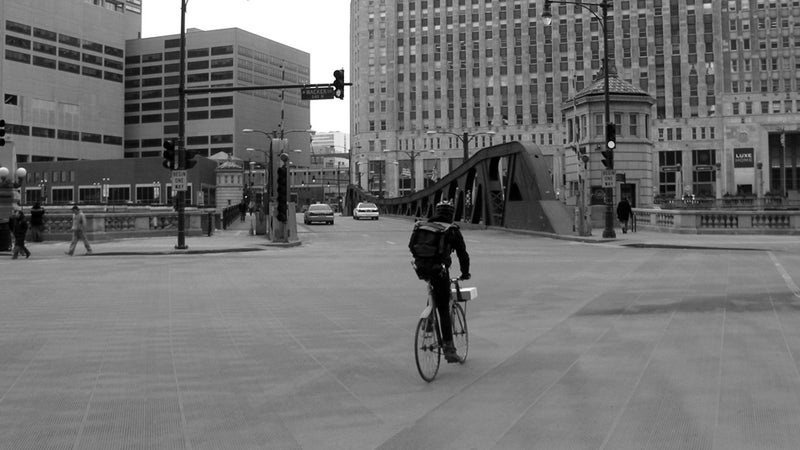The word “cyclist” can be a dirty one — particularly among the most passionate riders of bicycles. “Cyclist” can be a badge of honor, the thinking goes, but also a shortcut to stereotyping, more charged than “driver,” say, or “runner.” (You rarely hear about jogger-driver confrontations). I first wandered into this thicket while addressing a group of transportation advocates in Australia, and have since absorbed the lesson like a mantra: Better to say “a person on a bike.”
Take my own life. Saturday mornings might find me racing around Central Park predawn or joining the hundreds of riders who throng New York’s celebrated Route 9W. Yes, your quintessential Middle-Age-Man-in-Lycra (MAMIL). But later that day will find me with the family, pedaling our town bikes on New York City’s new protected lanes, with nary a stitch of performance clothing to be seen, to catch the ferry to Governors Island. During the week, I will grab a CitiBike in Midtown and ride it to a meeting in Chelsea, avoiding subway transfers and sitting in a gridlocked cab.
The point is: Cycling is not one thing, nor are cyclists one kind of person. But too often, we hear opposite sorts of messages. Cycling, in America, sometimes feels like an almost inescapably political act as much as a form of transport (Honey, I’m going to get some milk. And I’m problematizing the transportation monoculture!). And sometimes, it actually has to be. That is why, in a few weeks, I am joining Tim Johnson, the U.S. cyclocross champion rider and Red Bull athlete, along with 20 others (including pros like Chicagoan Christian Van de Velde), on a five-day ride from Kansas City to Chicago.
The ride is an outgrowth of Johnson’s previous Ride on Washington, which, in its first year, made its ragtag way from Boston—where the roads were icy and the temperature hung in the single digits—to the National Bike Summit in the nation’s capital, where the group lobbied legislators to help preserve funding for bike and walking programs in the federal budget. Johnson’s idea was simple: Connect the sport cycling world with all the other cycling worlds, as if to say: It’s all one road.
This year, Johnson says, wanting to “keep the ride fresh,” and to celebrate recent cycling advances in cities like Chicago (a successful bike sharing program, the city’s first on-street protected bike lane), he shifted to the Midwest. The starting point also has a particular emotional resonance for Johnson: It’s where he first landed on the podium, and where he again won the national cyclocross championship in 2007. Along the way, will meet with local riders, advocates, and officials. Johnson will be presenting the mayors of each city with framed prints depicting Strava “heat maps,” which reveal the most popular bike routes in each place, gleaned from Strava-tracked rides (the company is now selling the data as a transportation planning tool). The maps serve, notes Johnson, as a kind of “image of what their city is, and what it can be.”
There are many worthy rides for many worthy causes. This is the bike ride for better biking. The money raised goes to , the Boulder-based organization whose “Green Lane Project” helped virtually double the number of protected bike lanes in the U.S. from 2012 to 2013. While I will be dressed in lycra, I am not really riding to make things better for my weekend group ride. I am riding for that other part of my life, when I am with my wife and daughter and we are people on bikes.
There is a grand of virtuous circle I am hoping to promote here: The more that things like protected lanes—preferred by the majority of riders, as well as would-be riders—are built (often only thanks to special funding efforts kickstarted by advocates), the more people ride bikes (as cities from Atlanta to Indianapolis are witnessing firsthand). The more that people ride bikes, the safer it gets for people who ride bikes (New York City’s bike share program has seen many millions of trips with remarkably few injuries). Studies have shown that drivers who also ride bikes are better able to interact with bikes in traffic. Studies have also found, with motorcyclists, that people who have relatives who are motorcyclists are less likely to be involved in crashes with motorcyclists. It’s easy to imagine a similar dynamic with bicyclists: On-road empathy actually promotes traffic safety.
When we roll into Chicago on Memorial Day, I will be completing another kind of circle: In that city’s suburbs in the mid-1970s, during the first “bicycle boom,” I learned to ride a bike, a locally made Schwinn Sting-Ray. I still have the muscle memory of its grips in my hands, can still feel the smooth arc of the flecked banana-seat saddle. Some four decades later, I want to make sure my daughter has the chance to take that same ride.
To contribute to People for Bikes on behalf of Tom Vanderbilt (and have at chance at winning a new Garmin Edge 1000 bike computer) visit his .


